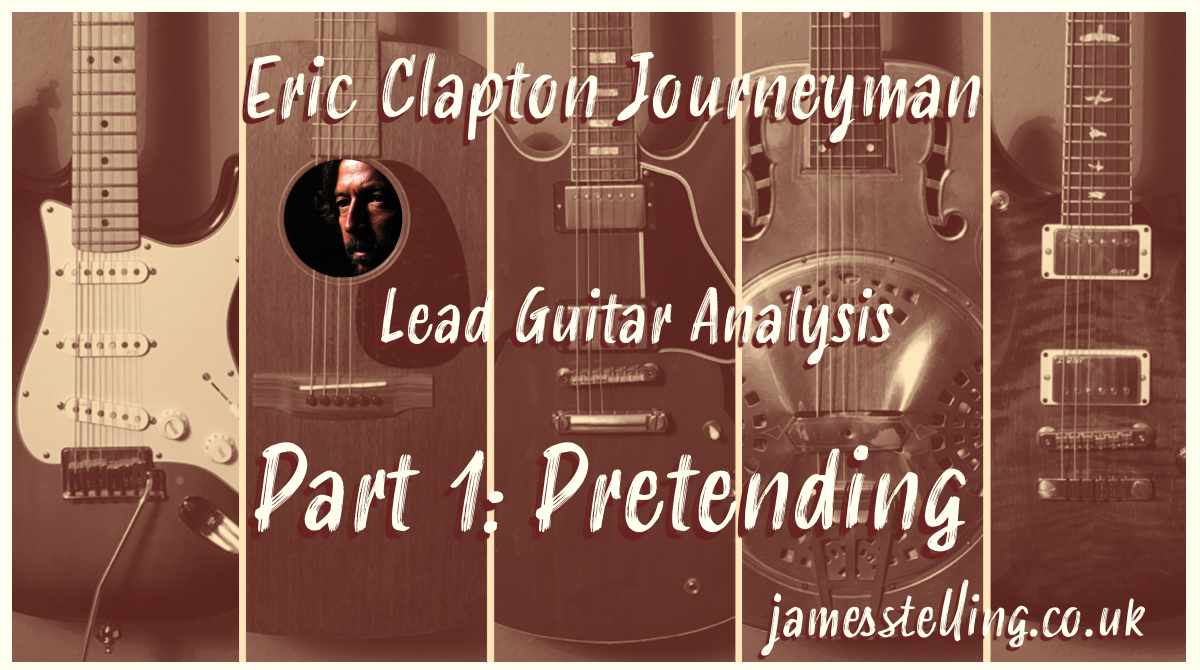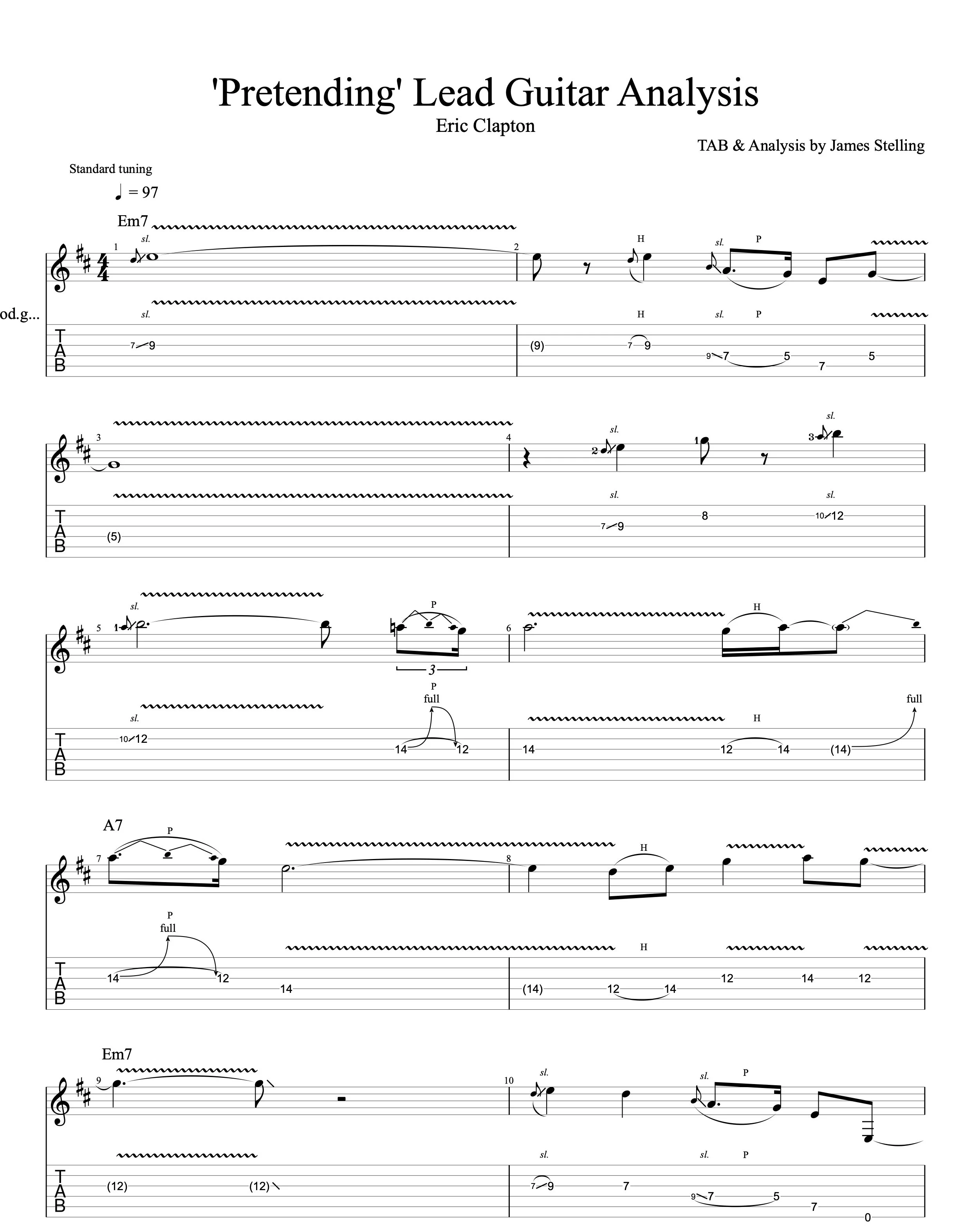Intro Analysis
Aim: To analyse Eric’s use of the Minor Pentatonic scale to create ‘authentic’ improvisational language.
In bar 1 Eric slides from the b7 of the Em Pentatonic up to the root. He does so with perfectly timed 16th note vibrato and manipulation of the wah pedal. Now this might seem like no big deal but you’d be surprised how many intermediate improvisers don’t ever think to do something this simple and effective. Another example of this idea being employed is by John Mayer at the beginning of his solo on ‘Belief’ albeit in this instance using the 5th and not the root.
In bar 2 Eric plays a slight variation of the tutti line heard at the end of the intro. A good thing to concentrate on here is the phrasing, as using an Em Pentatonic over an Em7 chord is bread & butter stuff for guitarists but many struggle to make this sound authentic. Look to the specific use of grace notes, slides, hammer-ons and pull-offs. Acquiring a strong command of these techniques improves your phrasing no end, as it allows you to finesse notes and phrases like an ‘advanced’ player. In the example I wrote, the phrase ends on the b3. However, in the recording, it is played as an overdub with the root note playing beneath. You can choose which way to play it.
Bar 4 is both a position shift (from position 4 of the minor pentatonic scale to position 1 in bar 5) and a useful little blues lick that you’ll hear often. Again the grace notes are what makes this sound authentic.
At the end of Bar 5 Eric plays a quick 16th note triplet phrase utilising a full tone bend to the 5th, releasing that bend to the 11th, pulling off to the b3rd before resolving back to the 11th in bar 6. Again, the specific use of bending notes and pull-offs is paramount to the success of this phrase. Your bends need to be perfectly pitched and all notes perfectly in time. Eric Clapton is exceptional at this.
Up until Bar 6 all notes of resolution have been notes from the Em7 chord - the root, the b3rd, the 5th - but in bar 6 Eric resolves to the 11th (A) implying an Em11 sound. It’s worth noting that this won’t always sound as strong as it does here. In this harmonic instance we’ve had 5 bars of Em7 so a flavour tone is very desirable. It wouldn’t work as well if you were resolving into a new Em7 chord with an 11th.
In Bar 6 & 7 Eric phrases over the barline (again with some exemplary bending) to resolve to the root of the Em Pentatonic scale. However, when he does this the root is now the 5th of the A7 being played over. This is something that intermediate players frequently fail to acknowledge, that the notes of a given scale mean something different harmonically when the chord has changed. For example the notes of Em Pentatonic E G A B D are th R b3 4 5 b7 of Em but are the 5th b7 R 2 4 of A7. If you analyse this you’ll see that we actually have 3/4 of the chord tones of A7 in this Em Pentatonic scale. This is why the scale is so interchangeable over Im7 to IV7.
In Bar 8 Eric plays a very simple Em7 pentatonic phrase over A7 that resolves to the b3rd of Em7 in bar 9. If you were to look at this without acknowledging the chords you’d think it very basic but again it sounds authentic. This is because it’s playing with your perception of the Em7 pentatonic over the A7 chord which then resolves to the Em7 chord. It’s as though the line Eric is playing pulls the harmony with him back to the Em7 (Im7) chord.
Bar 10 sees the tutti line that brings us into the verse. Here the specific delineation of grace notes, slides and pull offs are very important to get Eric’s authentic vocabulary under your fingers. It’s also worth noting the use of a rhythmic ‘push’ at the end of this phrase.
Takeaways:
Specific use of grace notes and legato techniques to acquire ‘authentic’ language.
Perfectly intonated bends, rhythmically accurate vibrato and subdivisions - you’d be amazed at the difference that working on achieving these 3 things has on your sounding authentic and not like an intermediate or beginner player. So many players pay little consideration to this stuff because it’s not exciting but it is essential. If you play with out of tune bends and vibrato that sounds like you’ve just been electrocuted then you’re not going to sound very listenable let alone very authentic.
Cognisance of the chords you’re playing over and how they frame the notes you’re playing. Playing into a chord change etc
How having a good command of rhythmic phrasing effects the power of your improvising. See the alteration of the tutti line in bar 2, the push at the end of bar 10, the general communication of rhythmic subdivisions etc


